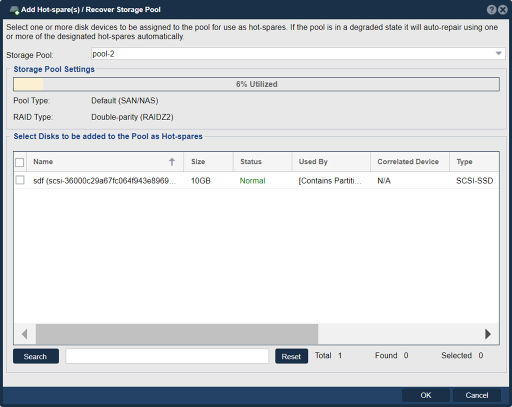Storage Pool Recover: Difference between revisions
mNo edit summary |
mNo edit summary |
||
| (17 intermediate revisions by the same user not shown) | |||
| Line 1: | Line 1: | ||
[[File: | [[File:Recover Strg Pool.jpg|512px|thumb|Add hot-spare drives to a storage pool.]] | ||
The "Add Hot-spare(s) / Recover Storage Pool" feature in QuantaStor serves two primary purposes: adding hot-spare drives to a storage pool and recovering a storage pool from a failed or degraded state. | |||
If you are using hardware RAID then you will mark hot-spare disks in the 'Hardware Enclosures & Controllers' section. This is the most common way of managing spare disk drives but you can also designate spares at the software RAID level using this dialog if you're using software RAID5/6/10/Z/Z2. | If you are using hardware RAID then you will mark hot-spare disks in the 'Hardware Enclosures & Controllers' section. This is the most common way of managing spare disk drives but you can also designate spares at the software RAID level using this dialog if you're using software RAID5/6/10/Z/Z2. | ||
'''Navigation:''' Storage Management --> Storage Pools --> Storage Pool --> | *Add Hot-spare(s): Hot-spare drives are unused drives that are kept in the storage system and are ready to automatically replace a failed or degraded drive in a storage pool. The "Add Hot-spare(s)" functionality allows you to designate one or more drives as hot-spares within a storage pool. These drives remain idle until a drive failure occurs within the pool. When a failure is detected, the hot-spare drive automatically replaces the failed drive, ensuring continuous operation and minimizing downtime. Adding hot-spares enhances the fault tolerance and availability of the storage pool. | ||
If a Storage Pool is in the DEGRADED state and a hot-spare device is added the system will automatically employ the hot-spare to start replacing the failed device and healing the pool. No other steps are required except to remove the failed device the hot-spare is replacing. The failed device does not need to be in the system while the re-silvering is happening but if you have multiple failed devices we recommend removing the failed devices after the re-silvering has completed. | |||
'''Navigation:''' Storage Management --> Storage Pools --> Storage Pool --> Add Hot-spare(s) ''(toolbar)'' | |||
<br> | |||
{{Template:ReturnToWebGuide}} | {{Template:ReturnToWebGuide}} | ||
[[Category: | [[Category:QuantaStor6]] | ||
[[Category:WebUI Dialog]] | [[Category:WebUI Dialog]] | ||
Latest revision as of 01:55, 8 August 2025

The "Add Hot-spare(s) / Recover Storage Pool" feature in QuantaStor serves two primary purposes: adding hot-spare drives to a storage pool and recovering a storage pool from a failed or degraded state.
If you are using hardware RAID then you will mark hot-spare disks in the 'Hardware Enclosures & Controllers' section. This is the most common way of managing spare disk drives but you can also designate spares at the software RAID level using this dialog if you're using software RAID5/6/10/Z/Z2.
- Add Hot-spare(s): Hot-spare drives are unused drives that are kept in the storage system and are ready to automatically replace a failed or degraded drive in a storage pool. The "Add Hot-spare(s)" functionality allows you to designate one or more drives as hot-spares within a storage pool. These drives remain idle until a drive failure occurs within the pool. When a failure is detected, the hot-spare drive automatically replaces the failed drive, ensuring continuous operation and minimizing downtime. Adding hot-spares enhances the fault tolerance and availability of the storage pool.
If a Storage Pool is in the DEGRADED state and a hot-spare device is added the system will automatically employ the hot-spare to start replacing the failed device and healing the pool. No other steps are required except to remove the failed device the hot-spare is replacing. The failed device does not need to be in the system while the re-silvering is happening but if you have multiple failed devices we recommend removing the failed devices after the re-silvering has completed.
Navigation: Storage Management --> Storage Pools --> Storage Pool --> Add Hot-spare(s) (toolbar)